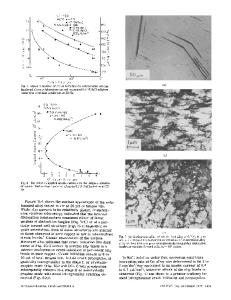The effect of cathodic polarization on the corrosion fatigue behavior of a precipitation hardened aluminum alloy
- PDF / 3,105,417 Bytes
- 9 Pages / 594 x 774 pts Page_size
- 70 Downloads / 356 Views
I. I N T R O D U C T I O N IT has been well established that high strength precipitation hardened aluminum alloys are highly sensitive to environmental degradation of their mechanical properties. This degradation can be exhibited as ductility loss, as spontaneous crack propagation under static loading (SCC), or as an increase in crack propagation rates under dynamic loading (CF). It has been noted that these alloys are sensitive to humid gaseous as well as liquid phase aqueous environments, and that, under a number of circumstances, preexposure of the alloys to these environments may also lead to ductility losses. 1-6 In general, the presence of chloride ion in the environment renders the alloys still more sensitive to environmental degradation, as do increases in the aggressivity of the environment. To date, however, there have been few studies which have successfully linked each of these phenomena, although it has been suggested that hydrogen, generated by interaction of the alloy with its environment, may be responsible for the observed degradation. This point has been disputed, however, and Ford has pointed out that, when corrosion studies of simulated crack tips are performed by either anodic or cathodic polarization, the actual reaction rate limiting process on the alloy surface is, at best, ambiguous. 7'8'9 A further complication arises in that most observed ductility losses which have been observed experimentally still show significant amounts of dimpled rupture on transgranular surfaces (indicating a significant amount of conventional ductility), while SCC generally exhibits intergranular failure. Corrosion fatigue generally occurs in a transgranular mode with what appears to be extensive stage I or crystallographic cracking. However, even in this case, the situation is complicated, since it has
E.F. SMITH, HI is with Olin Metals Research Labs., 91 Shelton Avenue, New Haven, CT 06504. D. J. DUQUETTE is with Rensselaer Polytechnic Institute, Materials Engineering Department, Troy, NY 12181. Manuscript submitted December 18, 1984. METALLURGICALTRANSACTIONS A
been observed that the corrosion fatigue fracture path shifts from the normally observed (111) fatigue fracture plane to either a (100) or (112) plane. 1~ Even in only mildly aggressive environments such as moist air, a shift in fracture path has been shown for single crystals, the latter observation being highly sensitive to test frequency (and presumably time of exposure relative to time available for crack advance). 12,14 The present study examines the effects o f cathodic potentials and subsequent hydrogen evolution on the fatigue characteristics of polycrystalline and monocrystalline high purity A1-Zn-Mg-Cu alloys. II.
EXPERIMENTAL PROCEDURE
Load controlled fatigue tests were performed on a high purity A1-Zn-Mg-Cu alloy in 0.5 N NaC1 solution as a function of electrochemical potential. The composition of the alloy was aluminum with 5.5 wt pct Zn, 2.5 wt pct Mg, and 1.5 wt pct Cu. Cast material was hot rolled to 2.5 mm and subsequently cold rolle
Data Loading...











